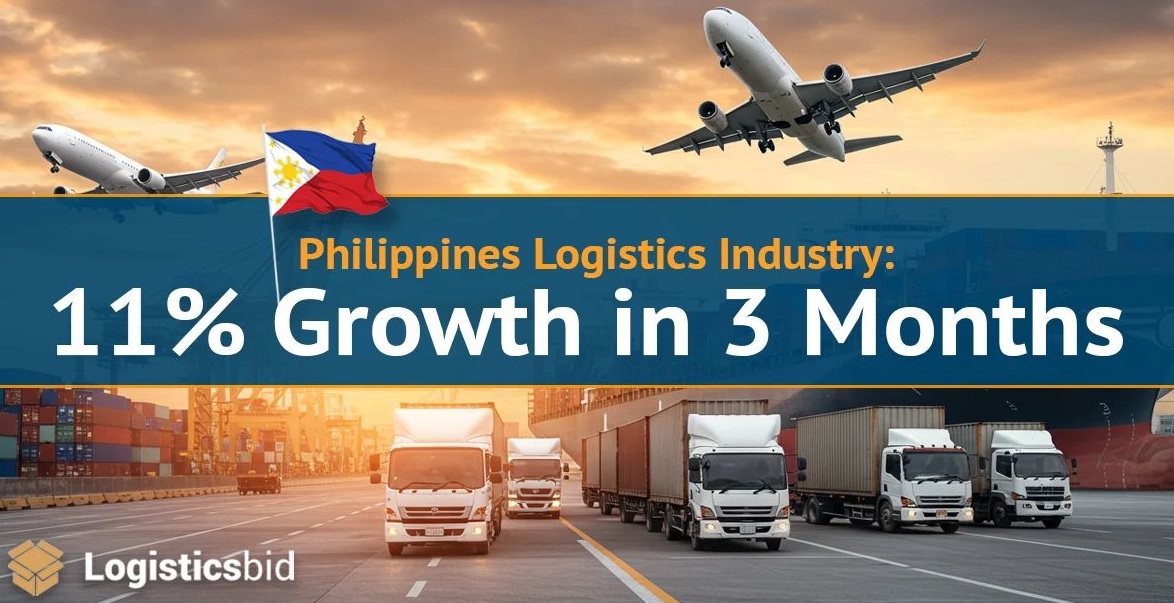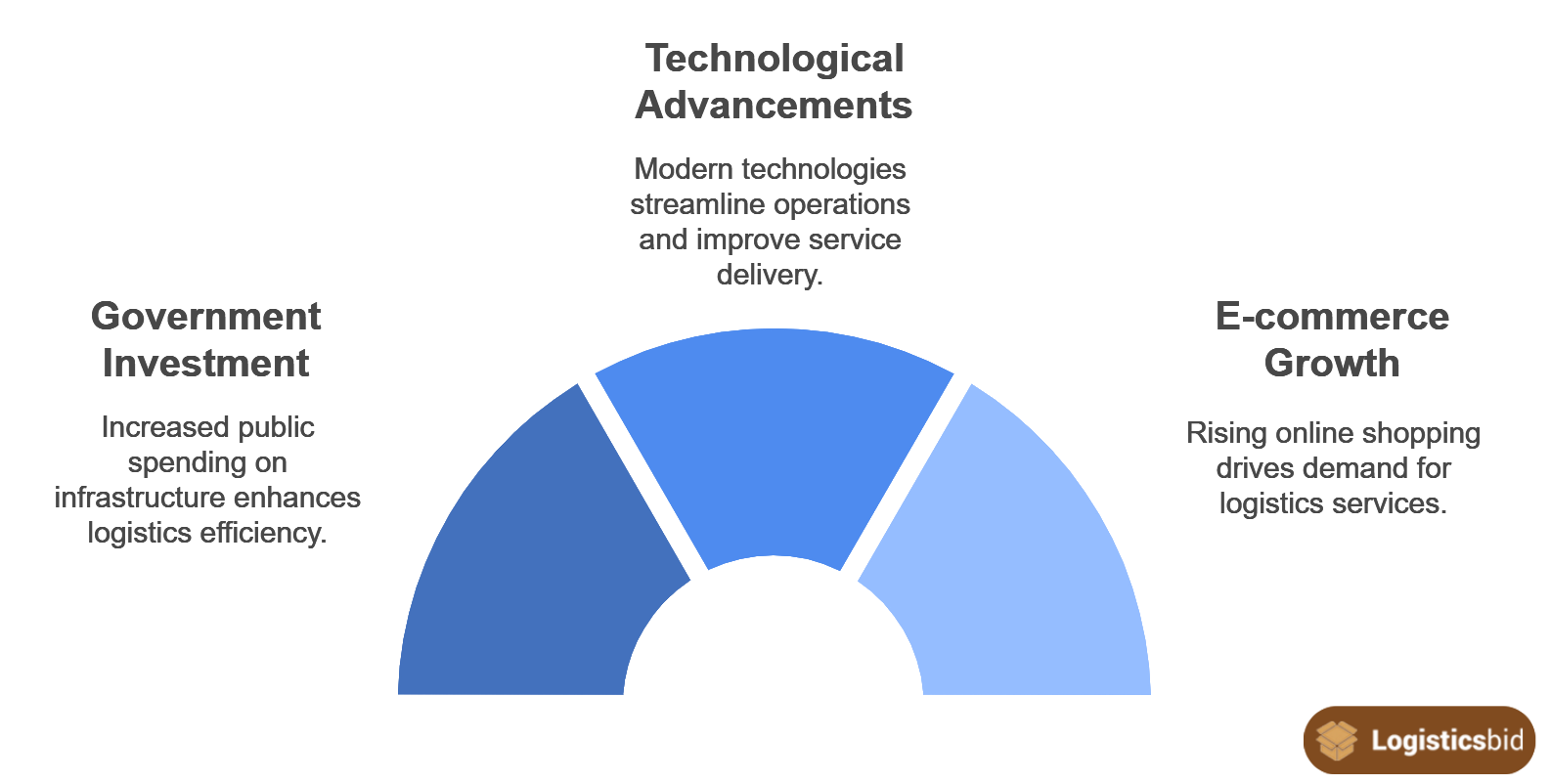
Recently, the Philippines has emerged as a key player in Southeast Asia’s economy, particularly in the logistics sector. The industry has grown by 11% in just three months. This is a notable achievement, and the numbers are impressive.
In this blog post, we will examine the primary factors driving this growth, assess the economic impact, and discuss the future outlook for the Philippines’ logistics industry.
Strong Growth in Cargo Traffic and Container Throughput
The Philippine Ports Authority (PPA) released data showing that cargo traffic in the nation’s ports increased by 11% from January to March of this year. It rose to 65.77 million metric tons (MMT) from 59.52 MMT during the same period last year.
Notably, container throughput increased from 1.8 million TEUs (twenty-foot equivalent units) to 2.04 million TEUs, representing a 13% increase. This expansion demonstrates the logistics sector’s adaptability and success, particularly in light of recent disruptions to international trade.
What Contributes to This Growth?

Several interlinked factors are driving this rapid expansion, including:
- Government Infrastructure Investment: Increased public spending has improved logistics infrastructure. This change allows for more efficient handling and shipment of cargo.
- Technological Advancements: The use of modern logistics technologies has streamlined operations and improved service delivery.
- E-commerce Growth: With more people shopping online, the demand for logistics services has surged, further driving industry growth.
The significant uptick in cargo movement indicates the sector’s solid footing amid global trade turbulence.
Navigating Tariff Uncertainties
Despite the turmoil caused by US President Donald Trump’s recent imposition of increased tariffs on several economies, including the Philippines, the logistics sector remains confident. The possible effects remain a cause for concern, even though this policy is currently on pause for ninety days, as of April 9. However, in an interview with The STAR, PPA General Manager Jay Santiago offered his thoughts, stating that these tariff risks are unlikely to cause any disruption to the domestic logistics sector.
Santiago pointed out that transshipment channels via China or Singapore are the primary means by which the Philippines trades with the US. This suggests an inherent buffer against future tariff-induced issues, as direct cargo transfers between the Philippines and the US are very modest.
Passenger Traffic Shows Slight Decline
The PPA recorded a 2% decrease in passenger volume, totaling 18.42 million in the same period, despite the expansion in freight transport. The reason for this decrease is that this year’s Holy Week vacations happened in April rather than March like they did in 2024. Similarly, there were 2.6 million passengers aboard roll-on, roll-off ships, a 7% decrease.

However, there is a silver lining. The PPA recorded 52 ship calls from cruise lines during this period. This shows that the Philippines is gaining a reputation as a desirable destination for high-end travelers. A total of 131,687 cruise passengers arrived in the first quarter. This positions the PPA on track to reach its goal of 185,000 cruise guests.
Financial Performance and Future Investments
Based on the data from the Philippine Ports Authority (PPA), the financial strength of the PPA boosts confidence in the logistics sector. By the end of March, the agency reported a net income of ₱3.88 billion, supported by rising revenues and effective spending cuts. Their earnings rose by 24% to ₱7.12 billion, while expenses dropped by 19% to ₱3.24 billion.
The PPA is integral to the Philippine government’s strategy, expected to remit some of the highest dividends among state-run firms. In 2024 alone, it contributed a record ₱5.2 billion, underscoring its economic impact.
In addition to generating revenue, the PPA is focused on improving logistics by investing in port upgrades. These improvements are crucial for enhancing cargo handling capabilities and fostering improved inter-island connectivity. They help keep the Philippine logistics landscape competitive.
The Role of Technology and Infrastructure in the Philippines’ Logistics Industry
What Technological Advancements Are Driving Growth?
The rapid growth of the Philippine logistics sector is largely driven by new technology. Investing in digital solutions, such as supply chain visibility tools, automation, and data analysis, has been crucial for improving operational efficiency. According to a 2023 International Trade Center analysis, businesses that use these technologies see productivity gains of up to 30%. In particular, logistics companies can make more informed decisions and streamline operations by leveraging tools such as artificial intelligence (AI) and the Internet of Things (IoT).
-
Automated Port Operations
Many ports in the Philippines, such as the Port of Manila, are now utilizing automated systems for cargo handling, which decreases turnaround time and boosts throughput. For instance, the introduction of smart containers equipped with IoT sensors enables real-time tracking of shipments, thereby reducing delays and enhancing customer satisfaction.
Why is Infrastructure Investment Crucial?
Infrastructure development is another cornerstone of the Philippines’ logistics strategy. The Philippine government has been aggressively investing in infrastructure projects, such as the Build, Build, Build program. According to the Department of Public Works and Highways (DPWH), over 1,000 infrastructure projects were completed in 2023, aimed at enhancing road networks, bridges, and port facilities.
-
Port Upgrades and Interconnectivity
Upgrades at major ports facilitate increased cargo capacity, while improvements in road networks enable faster transport of goods to and from ports. The PPA also highlighted the importance of enhancing inter-island connectivity, which is crucial for an archipelagic country like the Philippines. Improved logistics infrastructure supports not only trade but also enhances local economies, connecting businesses to larger markets.
Conclusion: A Bright Outlook Ahead
The study shows that the Philippine logistics sector is not only surviving but flourishing as a result of the difficulties surrounding international trade. The Philippines’ logistics industry has a very bright future thanks to robust cargo and container throughput statistics, little effects from external tariffs, and careful financial management. The Philippine logistics sector is in fact well-positioned for strong growth in the upcoming years as long as infrastructure investments and tourism continue to rise.
SEE ALSO:
- Emerging Tech: Grab’s Drone Delivery Pilot Testing
- How the 20% Trump Tariff on Philippine Exports to the US is Disrupting the Supply Chain
- Common Inquiries About Transportify: What Every Driver Should Know
More Philippines’ Logistics Industry Update Discussions
Digitalizing the Logistics Industry of the Philippines
Digital transformation is critical for the Philippine logistics sector. As emphasized in our article on Digitalizing the Logistics Industry of the Philippines, firms are using innovative software and data analytics to improve operations and customer engagement. Digital solutions enhance cargo management, helping the industry address current challenges while remaining competitive.
Effects of Oil Price Hikes on the Logistics Industry
Fluctuating oil prices have a major impact on logistics costs. As explained in our article on the Effects of Oil Price Hikes in the Logistics Industry, rising fuel costs force companies to change their pricing strategies. Utilizing efficient transport networks can help mitigate the effects of these costs, thereby maintaining strength during economic fluctuations.
Trends in the Transportation Logistics Industry
Various trends are shaping the logistics landscape. Our article on Trends in the Transportation Logistics Industry highlights the importance of sustainability, automation, and customer experience. Embracing these trends enables logistics providers to enhance competitiveness and adapt to changing market demands.
Modern Technology Innovating the Logistics Industry
Technology is changing logistics operations. Our article, ‘Modern Technology Innovating the Logistics Industry,’ highlights that advancements such as AI and blockchain are crucial for improving logistics processes. Using these technologies boosts efficiency and prepares the sector for future growth.
Stay tuned to Logisticsbid for more insights into the evolving landscape of the Philippine logistics sector and the factors driving its success.
